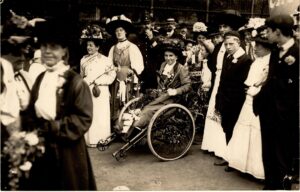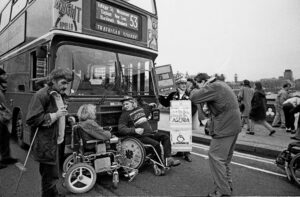Editor’s Note: Every year, people with disabilities become more visible in daily life and we think it’s important to understand where it began. The pictures below were recently featured in the Guardian and show forward-thinking women who laid the groundwork for the disability rights movement. It is written by Lucy Webster, a political journalist, writer and disability advocate.
Martin Luther King, Emmeline Pankhurst, Malcolm X, Rosa Parks. As a kid, I knew these names. I was taught about the brave things these people had done and the change they had created. They were people to look up to.
Somewhere along the way, I became aware that none of these people were disabled. Despite all the opportunities I was afforded by the Disability Discrimination Act (DDA), passed in 1995 when I was a few months old, I lived with the misguided idea that disabled people had never fought for our civil rights. I had no idea that I was only in the classrooms where I learned the names of King and Pankhurst because of people whose names were never mentioned.
As a disabled person, having a sense of your history is important. It helps you feel less alone. Helps you understand that the ableism you experience is part of a pattern across time and geography. Helps you see that change is possible. Helps you see, by providing the role models absent in pop culture or politics or business, the possibilities for your own life.
Over the past few years, my work as a journalist and activist has finally led me to learn some of the history of the disability rights movement. What I’ve found is that it is as rich as any other civil rights story, full of characters who believed things could be different and made them so. Not all of them set out to be, or even considered themselves, activists, but each of them has had a profound effect on the lives of disabled people. I’ve loved getting to know them – filling in a history I’ve been looking for since those primary school lessons – and I’ve loved finding out that the irreverence and style embodied by my fellow disabled activists today are just a continuation of what has gone before.
Creating change starts with growing awareness. So, to mark Disability History Month, let me share some of these fierce, feisty, overlooked characters with you.

My personal favorite, Rosa May Billinghurst was a wheelchair-using suffragette. She was one of the early members of the Women’s Social and Political Union and helped found its Greenwich branch in 1911. As a very visible presence at events and demonstrations, she became known as the “cripple suffragette” – possibly not the most politically correct moniker by today’s standards, but a sign of her importance to the movement. Billinghurst got around on a specially adapted tricycle, which became a central part of her image and historical legacy. At one demonstration, the police tried to stop her participating by confiscating her tire valves. At another, she used the trike to try to break through police lines. What more could you want from a heroine?

Eighty-odd years later, Barbara Lisicki was also out on the streets of London in her wheelchair, demanding rights for disabled people. The punk performer turned activist was the driving force behind the Disabled People’s Direct Action Network (DAN), the UK’s first nationwide disability rights organization. DAN organized successful protests against ITV’s charity telethon, which portrayed disabled people as pitiful and helpless, and inaccessible public transport systems, before turning its attention to forcing the passage of a general disability rights law. Thanks to pressure from Lisicki and DAN, and a brief illegal foray into the Palace of Westminster, parliamentary resistance was overcome and the landmark DDA was finally passed in 1995. Lisicki remains an icon of the movement, while DAN itself was revived during the pandemic to protest against the government’s failure to protect disabled lives.

Where there was Barbara, there was Alan – the pair were a couple during much of the time they were running DAN. Alan was a musician who used his lyrics for social justice – and it may have been those wordsmith skills that helped him coin the (in)famous “Piss on Pity” slogan during the 1990 and 1992 Block Telethon campaign. The campaign was hugely influential in changing how disabled people were seen and treated by the media. Alan is still a performer and activist; having moved to the US, he founded the country’s first Disability Pride event in 2013. It now takes place annually.
Leave a Reply